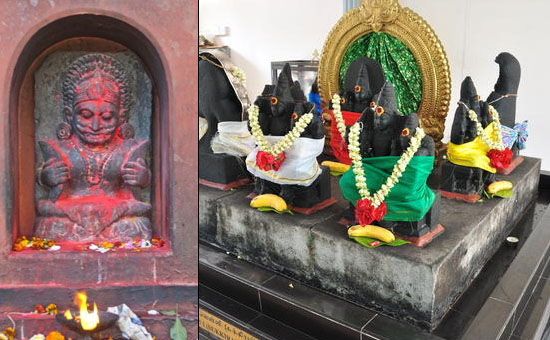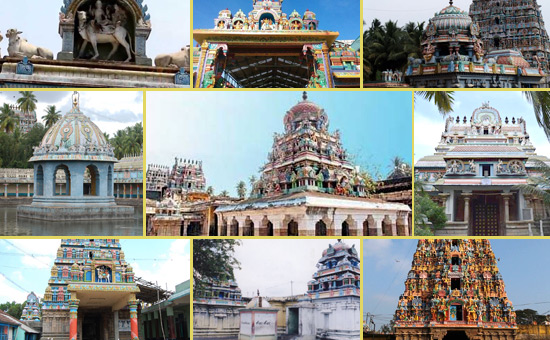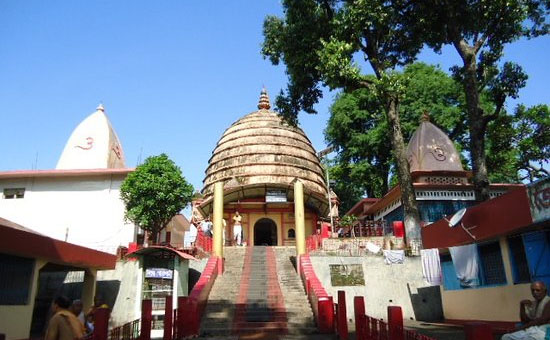- The
‘navagrahas’ or nine celestial bodies, which are an integral part of our solar
system, are known to have a profound impact on our lives. In addition to their
influences in our current life-time, the effect that these ‘grahas’ have on us
is representative of our ‘karmic’ past and indicative of what the future might
hold for us. Worshipping the ‘navagrahas’ remains an inherent aspect of our
tradition and is a cornerstone of our belief in the integrated and harmonious
existence of all the elements of our universe.
The
influence of the stars, planets and other elements of the cosmos on our
existence is undeniable. Planetary positions and conjunctions at a given point
in time can create, support and disrupt harmony in nature. While the energies
exerted by these forces have a visible and marked impact on life on our planet,
these energies also have an intangible, deeper connect with our everyday lives
– our joys and sorrows.
The
word graha means ‘to grasp’. Planets
are believed to grasp and exert karmic
forces that affect our lives, both in a positive and negative manner. A graha can be auspicious or inauspicious
for an individual or a group of people – even nations – based on its planetary
position at a given point of time. The subtle energies conveyed by the grahas affect the physical and mental
faculties of living beings, thus impacting our karmas and the consequences thereof.
Jyotisha-shastram, an important
branch of Vedic studies – also known as a Vedanga
or one of the limbs of the Vedas – is a comprehensive study of how the various
elements of the cosmos and their interplay affect our lives, individually and
collectively, and our karmas. The karma phalas or ‘fruits of our karmas’
are believed to have far-reaching outcomes across life-times. Astrological
charts are, therefore, drawn based on planetary positions and individual horoscopes
are made factoring in the location of different planets and their impact at the
time of one’s birth. A horoscope is, basically, a karmic chart. It is sort of a
balance sheet giving a snapshot of our assets and liabilities, in the form of
good and bad karmas as reflected by
the planetary conjunctions, and an analysis of the same provides information
about potential opportunities and pitfalls in our lives.
Worship
of the Sun, the Moon and other planets, together called as the Navagrahas or the nine celestial bodies,
is an important aspect of the Hindu way of life. These deities include the Sun
or Surya and the Moon or Chandra along with seven other planetary
bodies, namely, Mercury or Budha,
Mars or Mangala, Venus or Sukra, Jupiter or Brihaspati/Guru, Saturn or Sani
followed by Rahu representing the
North Lunar Node and Ketu
representing the South Lunar Node. Rahu
and Ketu are known as ‘shadow
planets’ and are depicted as the head and tail of a demonic snake,
respectively. Seven of the nine grahas
are linked to the seven days of the week as per the Hindu calendar and are also
worshipped individually on these days.
 All Navagrahas
All Navagrahas
Stories
and descriptions about the navagrahas
as well as their impact are found throughout our epics such as the Ramayana and
the Mahabharata and Puranas including
the Brahmanda Purana, the Matsya Purana, the Shiva Purana, the Linga Purana,
the Kurma Purana, the Garuda Purana, the Vayu Purana and the Bhavishya
Purana.
While
Maharishi Valmiki has given a detailed account of the planetary positions at
the time of Rama’s birth, Maharishi Vyasa has sketched out the astral landscape
leading up to the start of the great Mahabharata war. These details have now proved
extremely useful as we seek to ascertain possible dates for the key events of
the Ramayana and Mahabharata.
References
to planets and deities associated with them are also found in ancient Greek and
Roman literature and astrology.
Surya or Sun is
central to the solar system, the provider of energy and, therefore, represents
life-force, intelligence and prosperity. Chandra
or Moon is closely linked to water bodies and influences the mind and emotions.
Mangala or Mars is associated with
courage and aggression, while Budha
or Mercury impacts learning, analytical and communication skills. Guru or Jupiter symbolises wisdom and
knowledge and is considered a key catalyst for success, while Sukra or Venus stands for wealth, beauty
and desire. Rahu and Ketu are considered powerful points of energy and represent conflicts and ‘karmic’ effects from previous lives.
Sani or Saturn is
representative of austerity and discipline, which are important characteristics
for leading a spiritual and fruitful life. This graha is often misunderstood and feared to have sweeping negative
effects on people. However, under the influence of Sani, one develops a strong sense of responsibility and resilience,
the ability to endure and overcome hardships. Sani is also known to shower immense blessings and spiritual
strength.
A
popular folklore based on Ramayana highlights the defeat of Ravana at the hands
of Sani. Having brought the navagrahas under his control, Ravana
made them lie face down on the steps to his throne. Even Sani could not cast his spell on him as he was unable to face
Ravana from his position. It was then that Narada came to Ravana and mockingly
told him that the latter had no guts to face the navagrahas and that is why he had made them lie face down. His
pride pricked, Ravana ordered the navagrahas
to lie on their backs. This enabled Sani
to cast his spell on Ravana and set in motion the events that brought about his
downfall, paving the way for the final battle with Rama.
In
situations where particular grahas
are found to have negative influences, suitable remedial measures are suggested
including worship of those grahas on
their corresponding days of the week. A sight that
most temple-goers cannot miss on Saturdays, the day presided over by Sani, is the rush of devotees at
his shrine to light lamps and pray for relief from the myriad problems they
face in their day-to-day lives. These lamps are generally lit using pure
gingelly oil and made with wicks constituting black sesame seeds wrapped in
black coloured pieces of cloth.
 Lamps with sesame seeds
Lamps with sesame seeds
The
‘shadow planets’, Rahu and Ketu, are also believed to have malefic influences during certain
hours of the day. For instance, the duration of time wherein Rahu is believed to have negative
influence is known as Rahu kaalam.
Auspicious ceremonies and important new activities are usually not undertaken
during these hours.
The navagrahas are
also known to have an impact on the different parts of our bodies and their
smooth functioning.
For instance, Surya provides
longevity and good health, Chandra
has an impact on the digestive system, fertility and mental health, Mangala affects muscular strength, Budha causes respiratory and
skin-related issues, Guru impacts
metabolism, liver and pancreas, Sukra
the reproductive organs, while Sani
is associated with nerve-related issues and Rahu
and Ketu with fears and phobias.
The
navagraha shanti puja or navagraha homam, as it is popularly
known, is an elaborate Vedic ritual invoking the blessings of these grahas, and is performed by trained
priests or ritwiks, who chant mantras
and make offerings to them. This ritual is usually performed coinciding with
auspicious occasions in the family.
Most
temples in South India have, within the temple complex, a place devoted to the navagrahas, where devotees offer prayers
and do parikrama or circumambulate
the deities, nine times. The navagrahas are usually placed on a black coloured stone or granite pedestal. They are placed in a single square with Surya at the centre surrounded by the other eight deities.
Interestingly,
no two navagraha deities are placed
facing each other. The directions in which these deities are placed on the
pedestal typically based upon whether the temple follows Agama Pratishtha or Vaidika
Pratishtha. There are also other kinds of installations and manifestations
of the navagraha deities that are
found in different temples around the country.
Tamil
Nadu is home to many well-known navagraha
temples. According to tradition, the navagrahas
at the Navapashanam Temple, located at Devipattinam is said to be installed by
Lord Rama himself.
Kumbakonam
town in Thanjavur district has nine temples dedicated primarily to the worship
of Lord Shiva that have important pratishtanas
of each of the navagrahas, within the
respective temples. Suriyanar Temple is dedicated to Surya, Thinagaloor Temple to Chandra,
Vaitheeswaran Temple to Angaraka or Mangala, Thiruvenkadu Temple to Budha, Alangudi Temple to Guru, Kanjanoor Temple to Sukra, Thirunallaru Temple to Sani, Thirunageswaram Temple to Rahu and Keezhperumpallam Temple to Ketu.
 Navagraha Temples of Tamil Nadu.
Navagraha Temples of Tamil Nadu.
In
the vicinity of many of these temples, one can find the practitioners of naadi astrology, which includes
recommendations of suitable remedies for seekers, who are afflicted by various
problems on account of malefic influences of planets and their effects, over
many lifetimes.
The
navagraha temple on top of Chitrasal Hill in Guwahati, Assam, has nine Shivalingas representing the nine
celestial bodies, each covered with a garment of the colour that represents the
particular graha. The Shivalinga in the centre is symbolic of Surya. Among the many famous temples in
Maharashtra dedicated to the navagrahas,
the Sani temple at Shingnapur is renowned. The navagraha temple at Ujjain in Madhya Pradesh, on the banks of the river
Shipra is also well-known. Many temples in other parts of India too, now have
the navagraha pratishthas, within the
temple complexes.
 Navagraha Temple Chitrasal Guwahati
Navagraha Temple Chitrasal Guwahati
The
navagrahas are also represented in
the form of navagraha
vruksha vanas, which is a cluster of nine different trees that
correspond to each of the nine grahas.
Our
tradition of worshipping the navagrahas
with their different individual positive and negative characteristics and
effects, collectively as one unit, is a hallmark of the celebration of multiplicity
in our daily lives, in our ecosystems, in our universe.
References
1
Great Epics of India: Puranas by Dipavali Debroy and Bibek Debroy.
2
Placement
for nine planets
3
Why
do we worship Navagrahas
4
Navagrahas – Masters of Behaviour, Fortunes – A. Sathyanarayanan
Also
read
1
Jyotisha,
Hindu Astrology by Dr David Frawley
2
Visit
the famous Navagraha Temples of Tamil Nadu
3
Astrology
Science of the New Millenium
4
Guide
to visiting Navagraha Temples near Kumbakonam
5
What is Naadi Shastra